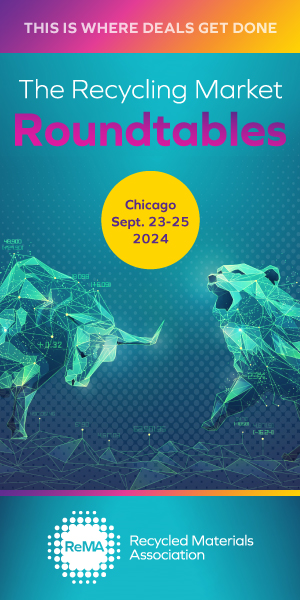Franziska Trautmann co-founded glass recycler Glass Half Full in 2020 with her Tulane University friend Max Steitz out of a desire to improve glass recycling in New Orleans. They wanted to turn recycled glass into a product that was functional and could improve the lives of local communities in its second life. Sand proved to be that product.
 Glass Half Full operates a free glass drop-off hub in New Orleans’ Gentilly neighborhood. Residents of any New Orleans parish are allowed to bring glass there; businesses must sign up for commercial pickup or drop-off.
Glass Half Full operates a free glass drop-off hub in New Orleans’ Gentilly neighborhood. Residents of any New Orleans parish are allowed to bring glass there; businesses must sign up for commercial pickup or drop-off.
The company also offers a door-to-door collection service for Orleans and Jefferson Parish residents. The company’s sand products are used for coastal restoration projects, disaster relief efforts, eco-construction, and new glass products.
Trautmann sat down with Scrap News to talk about the company, her goals, and where she hopes to see the industry in the future.
How did you start the company?
I always had an interest in the environment and in college I was studying chemical engineering, but I didn’t have a background in recycling.
I’ve lived in Louisiana my whole life and knew we didn’t have a strong recycling program. I met Max in college. He’s from New York City and had a better sense of how the recycling system works. One night during our senior year we were sharing a bottle of wine and pondered about how it was a shame that the bottle would end up in a landfill. We decided we would do something about it, however small it might be.
Initially, we thought [Glass Half Full] would be a small pet project, which is why we started it in the backyard. As we got started, we realized it would be too difficult to turn recycled glass into new glass. We did research to ship the glass cullet to a nearby manufacturer and decided that the financial burden of shipping it would be too great for us and the environmental burden (CO2 emissions) to ship it would also be detrimental. So, we decided to focus on the materials that are produced once recycled glass is broken down into smaller pieces—sand.
 We crush the glass into sand using our pulverizers and then sift the sand into different sizes. The smallest is a powder and the largest is gravel-size.
We crush the glass into sand using our pulverizers and then sift the sand into different sizes. The smallest is a powder and the largest is gravel-size.
Each size is used for different purposes. Our main goal is to use our product for coastal restoration projects. We’re finding that the coarse sand we create works best for that application. We use the finer sand for disaster relief sand as sandbags that we donate during hurricane season. And we’re exploring how to use the gravel in landscape, water management, and flooring projects.
There’s currently a global sand shortage. Could you tell me how Glass Half Full’s sand provides a sustainable alternative?
Our sand is an alternative to exploitative sand extraction techniques like dredging and mining, which disrupt local ecosystems, contribute to the coastal erosion crisis, and cost millions of dollars annually. Restoring Louisiana’s coast will require convergence of all types of ideas and glass is an important part of that solution.
 Our recycled sand can help restore Louisiana’s fragile shoreline. Our state has lost a quarter of its wetlands since the 1930s because of flood control structures designed to protect communities and businesses from flooding.
Our recycled sand can help restore Louisiana’s fragile shoreline. Our state has lost a quarter of its wetlands since the 1930s because of flood control structures designed to protect communities and businesses from flooding.
While well-intentioned, such structures prevented sediment from going into barrier islands and wetland areas by the Mississippi River’s spring floods, a natural process critical to preserving coastal areas. Consequently, land is disappearing much faster than it can regenerate.
Sand can help rebuild barrier islands and sandbars that protect the coast from tropical storms and hurricanes. Returning sediment to wetlands combats erosion and encourages the survival of native foliage and wildlife, which will strengthen Louisiana’s economy and preserve our food supply. Dunes, beaches, and even the rapidly eroding Gulf seafloor can benefit from sand deposition.
Sand is extremely valuable for its use in flood mitigation. New Orleans is vulnerable to tropical storms because it lies below sea level, is losing its protective coast, and is located off the Gulf of Mexico. As a result, NOLA is constantly experiencing both major and minor floods that inflict expensive damage to homes and businesses.
Our recycled sand is used to fill sandbags that protect vulnerable areas. Sandbags are also vital for levee maintenance because they can be used to help prevent overflow, manipulate the direction of water flow, absorb seepage, and for structural fortification. Our sand is sourced sustainably—not mined and extracted from our public commons—and donated or sold to those in need of this critical resource.
Can you tell me about Glass Half Full’s restoration projects?
We’ve been doing research for over a year with Tulane and funded by the National Science Foundation. We’ve had fully funded research to test the safety of the sand with plants, animals, and invertebrates.

We’ve also done coastal modeling and worked with civil and chemical engineers to determine the safety of the sand. Now that the research has proven the safety of recycled sand, we’ve been able to move to implementation.
The first coastal restoration demonstration was in collaboration with the Pointe-au-Chien Tribe, a state-recognized Native American Tribe located in Terrebonne and Lafourche parishes, Louisiana.
With the help of over 35 volunteers, we installed a glass gravel drain and rain garden with native plants in glass sand at Pointe-aux-Chenes. We used more than 10,000 pounds of our recycled glass sand and gravel for the project.
In the second project we partnered with the Coalition to Restore Coastal Louisiana and the U.S. Fish & Wildlife Service to repair damage from Hurricane Ida at the Big Branch Marsh National Wildlife Refuge, which is on the north shore of Lake Pontchartrain north of New Orleans.
We installed 20,000 pounds of recycled glass sand in burlap sacks and planted 5,000 native bulrush plants.
 We constructed a wall out of the sandbags that will naturally collect sediment over time and provide a protective barrier for the plants while they grow. By the time the burlap biodegrades, the new marsh grasses will have taken root and start to fill in the area blown out by the storm.
We constructed a wall out of the sandbags that will naturally collect sediment over time and provide a protective barrier for the plants while they grow. By the time the burlap biodegrades, the new marsh grasses will have taken root and start to fill in the area blown out by the storm.
Where do you want to see the recycling industry and Glass Half Full in the next several years?
It’s an industry that’s ripe for innovation. It’s been done the same way for a long time but we’re proving here in New Orleans that you can come up with new, exciting ideas in the recycling space and really make a difference in the environment.
We’re working to build a facility that can allow us to recycle all the glass in the region beyond the greater New Orleans area. We want to get investments in machinery and build a facility to make that happen, so hopefully we’ll be recycling a lot more in the next three to five years.
Photos Courtesy of Glass Half Full.










